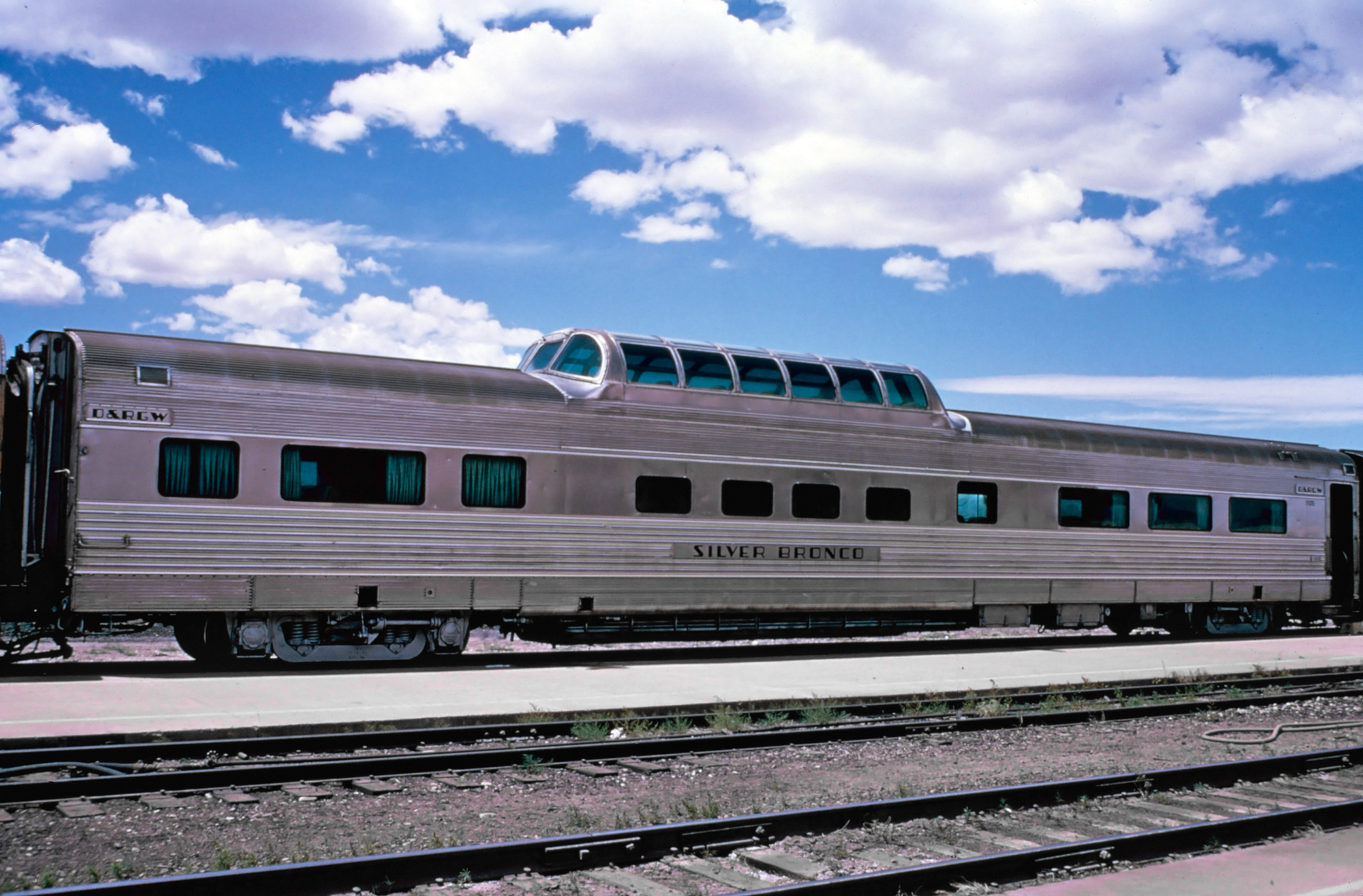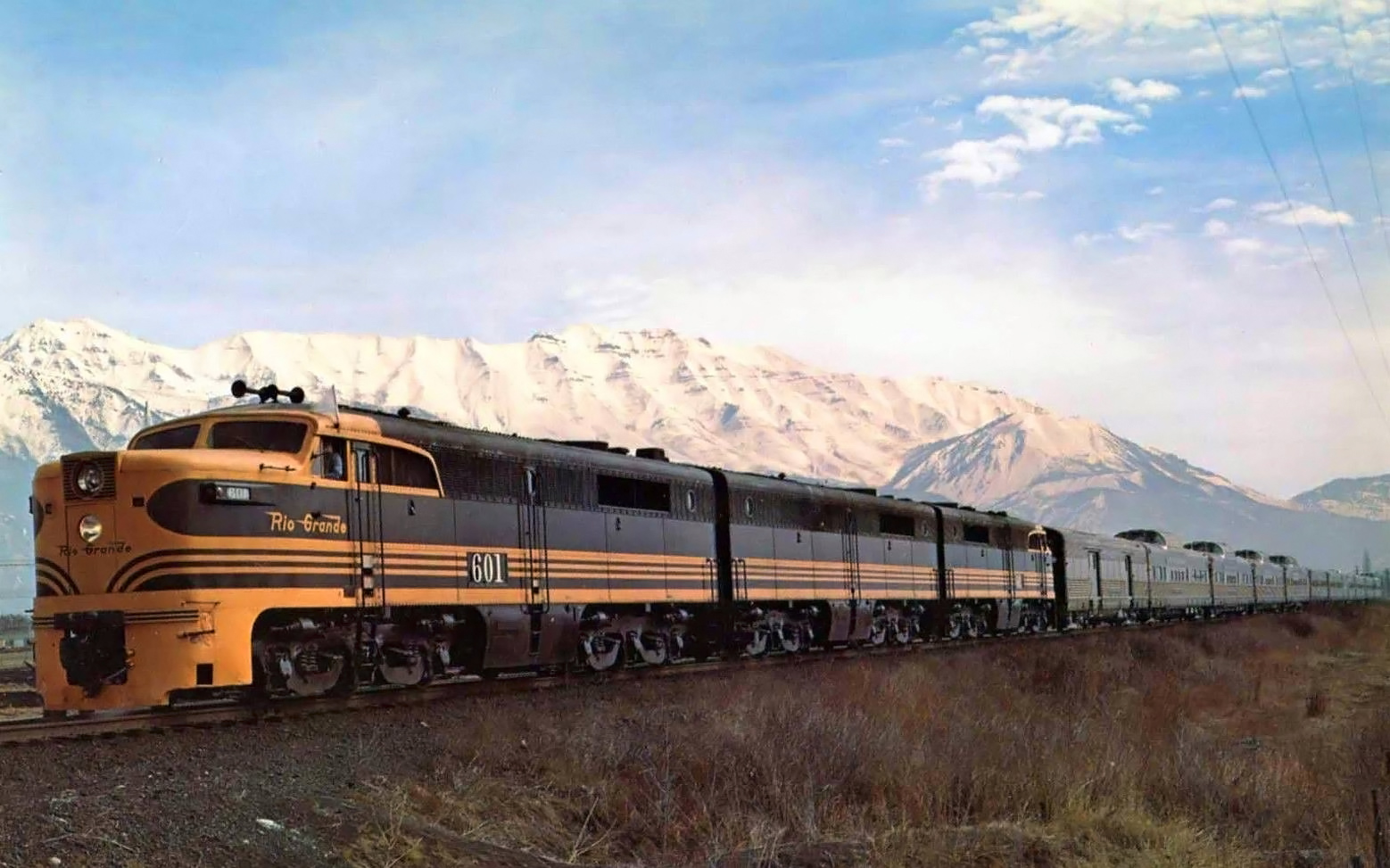- Home ›
- Passenger Cars ›
- Dome ›
- Vista-Dome
Vista-Dome (Train): History, Development, Specs
Published: February 6, 2025
By: Adam Burns
Railroading has a storied history in the United States, with countless innovations having left a lasting impact on both technology and culture.
One such transformational concept was the Vista-Dome. It revolutionized passenger travel by introducing a novel way to experience the scenic beauty of the surroundings.
This article delves into the history, design, impact, and cultural significance of the Vista-Dome, offering a comprehensive understanding of why it continues to be cherished in railroad lore.
 Rio Grande's Vista-Dome coach "Silver Bronco" attached to the "Rio Grande Zephyr" at Grand Junction, Colorado, circa 1975. Robert Eastwood, Jr. photo. American-Rails.com collection.
Rio Grande's Vista-Dome coach "Silver Bronco" attached to the "Rio Grande Zephyr" at Grand Junction, Colorado, circa 1975. Robert Eastwood, Jr. photo. American-Rails.com collection.Historical Context
To appreciate the significance of the Vista-Dome, one must first consider the context of its introduction. The mid-20th century was a pivotal time for passenger railroads.
Facing burgeoning competition from automobiles and, later, commercial aviation, railroads were in dire need of an innovative solution to attract travelers. The industry had been facing this issue since the economic struggles of the 1930s and introduced the streamliner to combat passenger losses at that time.
Prior to the modern streamlined dome cars, the design could be traced back to the 19th century. Its earliest documented predecessor, known as the "birdcage car," emerged in the 1880s and was utilized for an 1882 sightseeing tour on the Chicago, Burlington & Quincy (CB&Q).
In 1891, T. J. McBride secured a patent for an "observation-sleeper" car design, which included illustrations of three observation domes as featured in Scientific American.
The Canadian Pacific also explored similar innovations by introducing "tourist cars" with elevated, glass-sided viewing cupolas during the 1920s to enhance the travel experience through the Canadian Rocky Mountains.
Postwar Development
Despite these early attempts, dome car designs initially proved unsuccessful. The first successful iteration was conceptualized by Cyrus Osborn of General Motors’ Electro-Motive Division in 1944.
While traversing Glenwood Canyon in Colorado from the head-end of a Rio Grande FT diesel, Osborn identified the exceptional vistas passengers could appreciate from a panoramic dome. This realization led to his proposal for a car offering a full 360-degree view that he dubbed the "Vista Dome."
Osborn presented his concept to the CB&Q, which subsequently transformed a stainless steel Budd-built coach in their Aurora, Illinois shops into the Vista Dome concept Osborn had envisioned.
This initial creation was aptly named Silver Dome and tested on the Twin Cities Zephyr on July 23, 1945. Vista Domes swiftly integrated into many Burlington Zephyr train sets, culminating in the launch of the California Zephyr in 1949.
Following Silver Dome's debut, discussions arose among railroad executives regarding the dome car's practicality. Its optimal use was largely confined to railroads west of the Mississippi River where tunnel clearances permitted their operation.
By contrast, Canadian Pacific managed to operate dome cars coast to coast. Additionally, concerns were voiced about the non-revenue nature of the passenger space within the domes, as it was assumed travelers would not occupy them for the entirety of their journey.
These elements, along with the augmented expenses related to staircase installation, two-level car flooring, and air conditioning, contributed to higher operational costs for railways opting for dome cars.
Nevertheless, Pullman manufactured the initial four production dome cars for GM's Train of Tomorrow in 1947. These cars, named Astra Liners, comprised a coach, diner, sleeper, and lounge-observation, and mirrored the Silver Dome's layout.
They were showcased at private events and to the public at the Chicago Railroad Fairs in 1948 and 1949 prior to being acquired by the Union Pacific for service between Portland, Oregon, and Seattle, Washington.
Subsequently, other car manufacturers released competing dome car models, notably Budd's first domes featuring curved glass and streamlined effects, which debuted on the Burlington’s Twin Zephyrs connecting Chicago with Minneapolis-St. Paul in the fall of 1947.
Design and Innovation
The defining feature of the Vista-Domewas its transparent, glass-enclosed observation dome located on the top of the car. This dome was raised above the main roofline, providing panoramic 360-degree views of the passing landscape. In the context of the time, this was a radical departure from traditional railcar design, which often limited visibility to side-facing windows.
The design was both simple and complex. The simplicity lay in its purpose – to foster an immersive travel experience by bridging the gap between indoor comfort and the outdoor environment.
However, engineering such a car required careful consideration of weight distribution, structural integrity, and passenger safety. Dome cars had to withstand the rigors of varying weather conditions, including snow and ice, while ensuring that the glass panels did not obstruct visibility. Additionally, the extra height had to comply with tunnel and bridge clearances.
To achieve this, manufacturers like the Budd Company utilized stainless steel for the car bodies. This choice provided resilience and reduced weight, factors crucial for the structural needs of a dome car.
 The original "California Zephyr" (1949-1970) was far different from the version operated today by Amtrak; it was faster (50 hours between San Francisco - Chicago compared to Amtrak's 51+), more scenic, offered far more accommodations, and was scheduled specifically to ensure guests could view the western vistas during daylight hours.
The nearly-all Vista-Dome train's consist typically included a baggage car, three reclining-seat Vista-Dome coaches, a Vista-Dome dormitory-buffet-lounge (with its "Cable Car Room" featuring murals and motifs from the Bay Area and even featured scale models of San Francisco's trademark cable cars), full diner, four sleepers, and the Vista-Dome sleeper-lounge observation.
This Rio Grande publicity photo features a PA/PB/PA set of the demonstration train for the soon-to-be-launched "California Zephyr" in Utah on March 14, 1949. It officially entered service on March 20th.
The original "California Zephyr" (1949-1970) was far different from the version operated today by Amtrak; it was faster (50 hours between San Francisco - Chicago compared to Amtrak's 51+), more scenic, offered far more accommodations, and was scheduled specifically to ensure guests could view the western vistas during daylight hours.
The nearly-all Vista-Dome train's consist typically included a baggage car, three reclining-seat Vista-Dome coaches, a Vista-Dome dormitory-buffet-lounge (with its "Cable Car Room" featuring murals and motifs from the Bay Area and even featured scale models of San Francisco's trademark cable cars), full diner, four sleepers, and the Vista-Dome sleeper-lounge observation.
This Rio Grande publicity photo features a PA/PB/PA set of the demonstration train for the soon-to-be-launched "California Zephyr" in Utah on March 14, 1949. It officially entered service on March 20th.Impact on Rail Travel
The introduction of the Vista-Domes brought a heightened level of prestige and comfort to train travel. At a time when automobiles offered privacy and flexibility, the dome cars enticed passengers back to rail by offering something cars could not: unobstructed scenic views combined with the luxury and conviviality of the railroad experience.
The Vista-Dome was not merely about sightseeing; it symbolized a new renaissance in passenger rail travel. Railroads soon recognized their potential, and dome cars became the hallmark of flagship services.
The CB&Q’s California Zephyr, "a train for travelers," often dubbed this due to its combination of speed, service, and the breathtaking sightseeing offered by its five domes, became emblematic of their success.
Beyond CB&Q, various railroads across the nation, including the Great Northern and Northern Pacific, embraced domes for transcontinental and regional services. Their appeal was universal, offering city dwellers and rural folk alike a splendid view of America’s grand landscapes – be it the rugged Rockies or the vast Midwest plains.
Cultural Significance
The Vista-Dome's impact extended well beyond the steel tracks and station platforms; it permeated popular culture and collective memory.
The cars captured the post-war optimism of America – a country looking forward, inspired by its capability for innovation and design. This optimism was not just about technology, but also about reconnecting with the land and its diverse geographies.
Hollywood and media further amplified the romanticism of the Vista-Dome experience. Films and travelogues featuring dome cars highlighted their unique allure, solidifying their place as cultural icons. They became synonymous with the American spirit of exploration, the joy of travel, and the sophistication of mid-century modern design.
With time, even as rail travel diminished, the allure of the domes did not wane. Tourist operators and preservationists revived dome cars, allowing new generations to glimpse the elegance and nostalgia associated with this golden era of railroading. Many historic rail excursions today still tout the Vista-Dome experience as their main attraction, a testament to its enduring legacy.
Legacy
The Vista-Dome was much more than an engineering milestone; it was a symbol of an era where travel meant more than just getting from point A to B.
It represented an intricate weaving of engineering, aesthetics, and human experience, transforming the way passengers interacted with their surroundings. It played a critical role during a transformative period in American history, bolstering the prominence of rail as a mode of travel.
Today, the few surviving Vista-Dome cars continue to inspire and captivate. They offer more than just transportation; they provide a window—quite literally—into the past, a nostalgic reminder of the innovation and luxury that once graced the American railroads.
Recent Articles
-
Alabama Father's Day Train Rides: A Complete Guide
May 07, 25 04:37 PM
Alabama, with its rich railway heritage and scenic countryside, presents several exciting options for Father’s Day train rides that promise adventure and nostalgia coupled with the warmth of family bo… -
Washington Mother's Day Train Rides: A Complete Guide
May 06, 25 03:27 PM
Washington State is renowned for its breathtaking landscapes, which can be experienced on a scenic train. One location hosts special trips for mom, the Lake Whatcom Railway. -
Oregon Mother's Day Train Rides: A Complete Guide
May 06, 25 01:49 PM
If you're looking for a unique and memorable way to celebrate this occasion in Oregon, why not consider a scenic train ride?


